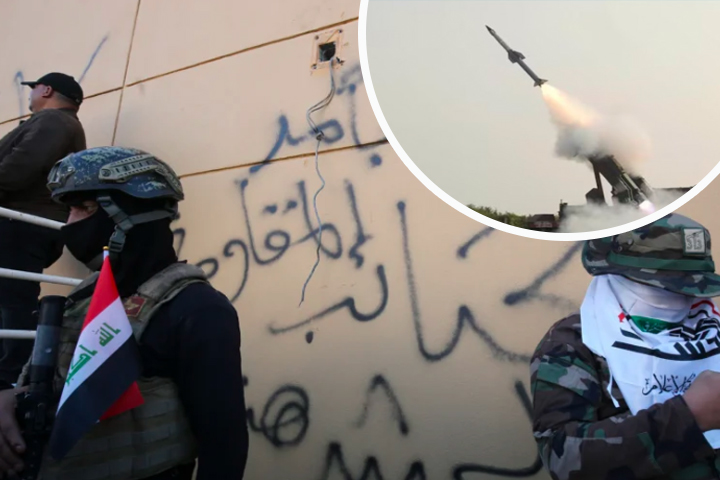


Iraqi and American servicemen were injured on Saturday night when rebels supported by Iran attacked international coalition forces at Iraq's Ain Al-Asad Airbase, also known as al-Assad, or "the Lion."
According to the U.S. Central Command (CENTCOM), several ballistic missiles and rockets were fired against the main airfield at around 6:30 p.m. Some of the missiles found their objective, despite the fact that the base's air defense systems intercepted a large number of them.
“Damage assessments are ongoing,” CENTCOM said in a statement. “A number of U.S. personnel are undergoing evaluation for traumatic brain injuries. At least one Iraqi service member was wounded.”
The airfield, which is regarded as the western counterpart of Baghdad's Green Zone, was hit by a ballistic missile on Nov. 20, signaling a significant increase in force and the employment of more potent ballistic missiles. Eight troops were injured in the strike. The United States responded with a retaliatory strike, killing several Iranian-backed militia members.
On January 8, 2020, the base was subjected to a significant strike by around thirty Iranian ballistic missiles.
The chief of the Iranian regime's overseas military wing, the Quds Force, Qassem (also known as Qasem or Qasim) Soleimani, was killed a few days prior by a drone attack carried out by the United States, according to the Islamic Revolutionary Guard Corps (IRGC), which at the time claimed credit for the action. According to US President Donald Trump and the Pentagon at the time, Soleimani was "actively developing plans to attack American diplomats and service members in Iraq and throughout the region," which prompted the targeted strike.
For the base's defense after that, the Pentagon installed Patriot air defense systems.
Thirteen of the approximately fifteen missiles that were launched in the attack were successfully intercepted, according to preliminary findings on Saturday. But two of them found the base.
In a statement posted on Saturday, the "Islamic Resistance in Iraq," a group with ties to Iran, claimed responsibility for the attack.
Earlier on Saturday, Tehran reported that in the Mazzeh neighborhood of Damascus, which is also home to the local U.N. office, an Israeli strike on a multi-story residential building had killed the IRGC's spy chief for Syria, Brigadier General Sadegh Omidzadehh (also known as Hojjatollah Omidvar or “Hajj Sadegh”), his deputy, and three other IRGC members. situated both international embassies and headquarters. Saeed Karimi, Hossein Mohammadi, and Ali Aghazadeh were also identified by IRGC-affiliated state media as advisers that were slain in the assault.
The IRGC-owned building in a neighborhood known by locals as a high-security zone for IRGC leaders and pro-Iran Palestinian factions is said to have been the location of a meeting for the leaders, who the director of the UK-based Syrian Observatory for Human Rights described to the AFP as "Iran-aligned leaders." Reports state that the Syrian defense ministry reported additional civilian casualties at the residential complex.
As both regional heavyweights continue to vie for dominance, Tehran warned retaliation. According to state media, Iran's foreign ministry accused Israel of making a "desperate attempt to spread instability in the region."
After the terrorist group Hamas attacked Israel on October 7, 2023, U.S. and Coalition troops in the region have been subject to recurrent strikes by Iranian proxies since mid-October. Since October 7, over 100 U.S. soldiers have been attacked in Iraq and Syria; the Pentagon said that dozens of them had suffered minor injuries.
The Pentagon has undertaken strikes on many occasions, claiming that they were necessary to deter potential attacks or stop them from happening. According to Air Force Maj. Gen. Pat Ryder, the Pentagon Press Secretary, Iranian proxies are engaged in a strategic game of driving out American soldiers from the area on December 12 of last year.
In an effort to completely destroy Hamas's military capabilities, Israel has stepped up its attacks on prominent Iranian and allied officials in Syria and Lebanon, home to Iran-backed Hezbollah. These attacks have occurred in recent months.
Israel carried out an airstrike in December that resulted in the death of senior Iranian commander Razi Moussavi, who commanded the IRGC's Quds Force in Syria. Moussavi was a close companion of Soleimani.
The attack in Lebanon on January 2 that claimed the life of Hamas lawmaker Saleh al-Arouri was attributed to Israel. A deadly attack on top Hezbollah leader Wissam Tawil in his vehicle in south Lebanon came next.
In an effort to put a stop to Israel's military assault against Hamas in Gaza, the Pentagon announced on January 16 that it had intercepted a large quantity of "advanced conventional weapons" that Iran was supplying to the Houthis, who had been targeting foreign boats in the Red Sea from Yemen.
At the moment, the United States has around 2,500 soldiers in Iraq and about 900 in Syria.
As part of Operation Iraqi Freedom, the United States formally left the facility in 2011, but it later returned in 2014 to fight with Iraqi troops in a multinational coalition against the terrorist organization ISIS, which had taken over vast portions of the nation before being routed.